美国教育方式 英文版
- 格式:ppt
- 大小:10.68 MB
- 文档页数:27

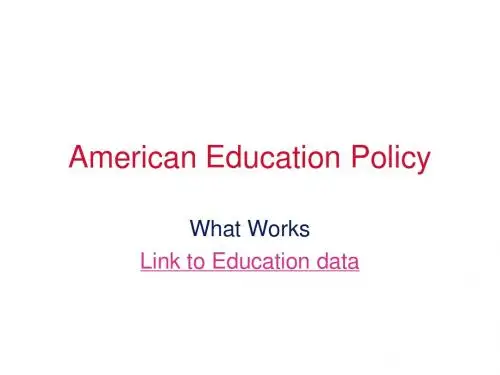
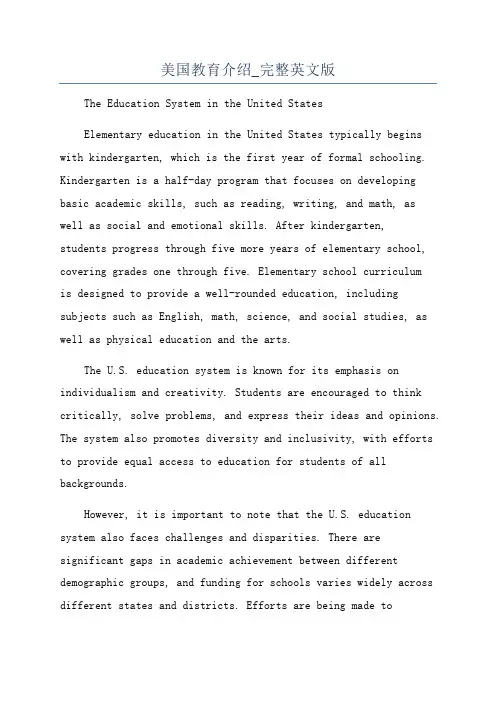
美国教育介绍_完整英文版The Education System in the United StatesElementary education in the United States typically begins with kindergarten, which is the first year of formal schooling. Kindergarten is a half-day program that focuses on developing basic academic skills, such as reading, writing, and math, aswell as social and emotional skills. After kindergarten,students progress through five more years of elementary school, covering grades one through five. Elementary school curriculumis designed to provide a well-rounded education, including subjects such as English, math, science, and social studies, as well as physical education and the arts.The U.S. education system is known for its emphasis on individualism and creativity. Students are encouraged to think critically, solve problems, and express their ideas and opinions. The system also promotes diversity and inclusivity, with efforts to provide equal access to education for students of all backgrounds.However, it is important to note that the U.S. education system also faces challenges and disparities. There aresignificant gaps in academic achievement between different demographic groups, and funding for schools varies widely across different states and districts. Efforts are being made toaddress these issues and improve the overall quality of education in the United States.。
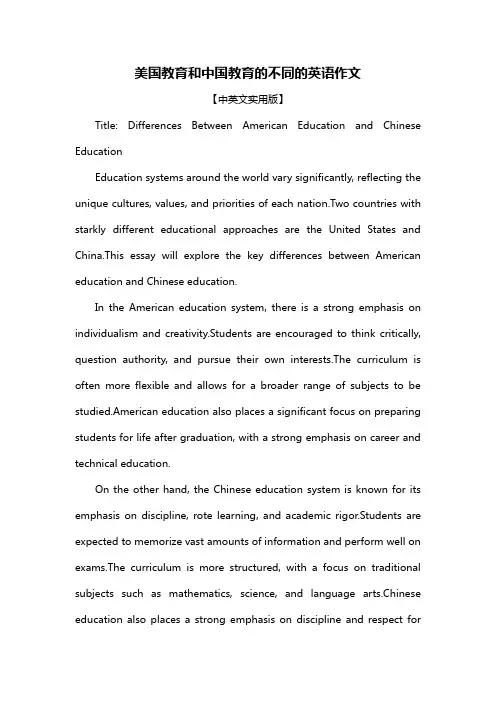
美国教育和中国教育的不同的英语作文【中英文实用版】Title: Differences Between American Education and Chinese EducationEducation systems around the world vary significantly, reflecting the unique cultures, values, and priorities of each nation.Two countries with starkly different educational approaches are the United States and China.This essay will explore the key differences between American education and Chinese education.In the American education system, there is a strong emphasis on individualism and creativity.Students are encouraged to think critically, question authority, and pursue their own interests.The curriculum is often more flexible and allows for a broader range of subjects to be studied.American education also places a significant focus on preparing students for life after graduation, with a strong emphasis on career and technical education.On the other hand, the Chinese education system is known for its emphasis on discipline, rote learning, and academic rigor.Students are expected to memorize vast amounts of information and perform well on exams.The curriculum is more structured, with a focus on traditional subjects such as mathematics, science, and language arts.Chinese education also places a strong emphasis on discipline and respect forauthority.Another key difference between the two systems is the role of parents and teachers.In America, parents are often more involved in their children"s education, and there is a greater emphasis on student-teacher communication.Teachers are seen as facilitators of learning, and the relationship between students and teachers is often more egalitarian.In contrast, Chinese education places a stronger emphasis on respect for authority and strict discipline.T eachers are seen as authorities, and students are expected to comply with their instructions.Parents also play a more passive role in their children"s education, with less involvement in school activities.Furthermore, the goals of education differ between the two countries.In America, the primary goal of education is often seen as preparing students for life after graduation, with a focus on developing critical thinking skills and fostering individuality.In China, the primary goal of education is often seen as preparing students for college and career success, with a focus on academic achievement and discipline.In conclusion, there are several key differences between American education and Chinese education.American education emphasizes individualism, creativity, and preparing students for life after graduation.Chinese education, on the other hand, emphasizes discipline, rote learning, and academic rigor.These differences reflect the uniquecultures, values, and priorities of each nation.。
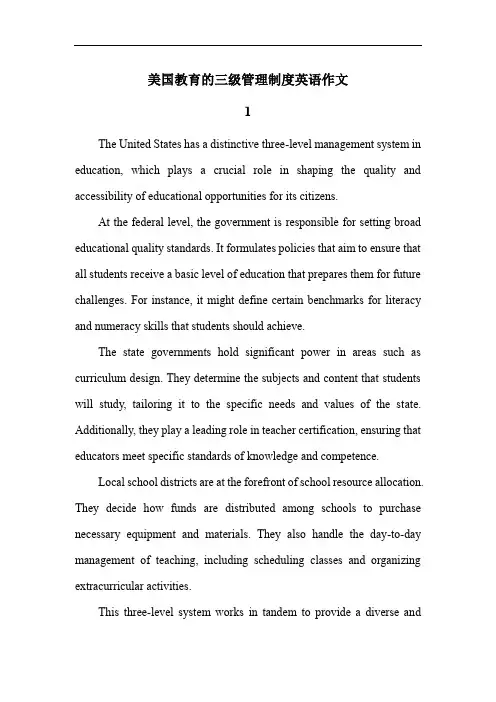
美国教育的三级管理制度英语作文1The United States has a distinctive three-level management system in education, which plays a crucial role in shaping the quality and accessibility of educational opportunities for its citizens.At the federal level, the government is responsible for setting broad educational quality standards. It formulates policies that aim to ensure that all students receive a basic level of education that prepares them for future challenges. For instance, it might define certain benchmarks for literacy and numeracy skills that students should achieve.The state governments hold significant power in areas such as curriculum design. They determine the subjects and content that students will study, tailoring it to the specific needs and values of the state. Additionally, they play a leading role in teacher certification, ensuring that educators meet specific standards of knowledge and competence.Local school districts are at the forefront of school resource allocation. They decide how funds are distributed among schools to purchase necessary equipment and materials. They also handle the day-to-day management of teaching, including scheduling classes and organizing extracurricular activities.This three-level system works in tandem to provide a diverse andcomprehensive educational experience. Each level has its unique responsibilities and contributions, collectively striving to offer quality education that meets the diverse needs of students across the nation. The collaboration and balance among the federal, state, and local levels are essential for the continuous improvement and success of the American educational system.2The three-level management system of education in the United States plays a crucial role in shaping the educational landscape of the country. At the federal level, the government provides substantial financial support, which has significantly contributed to promoting educational equity. For instance, it funds educational programs for disadvantaged students, ensuring they have access to quality education. However, there might be inconsistencies in the implementation of policies across different states.The state governments, on the other hand, enjoy flexibility in formulating policies to meet the specific needs of their localities. This adaptability allows for customization based on regional characteristics and priorities. However, it could potentially lead to significant differences in educational standards and opportunities among different states.The local school districts have direct management over educational institutions within their boundaries. They are better positioned to understand and address the needs of the local community. But the resourceallocation could be imbalanced, with some districts having abundant resources while others struggle to meet basic requirements.In conclusion, the three-level management system of education in the United States has its strengths and challenges. A balanced and coordinated approach among the federal, state, and local authorities is essential to optimize the educational system and provide quality education for all students.3The educational management system in the United States is characterized by a three-level administrative structure, which sets it apart from many other countries. In contrast to the centralized educational management model in some European countries, the United States grants more autonomy to states and local communities. For instance, in certain European nations, educational policies and curricula are often dictated by the central government, leaving little room for local variations and adaptations. However, in the United States, states have the authority to formulate their own educational standards and curricula, based on the specific needs and circumstances of their regions.When compared to some Asian countries where local autonomy is relatively limited, the American system provides greater flexibility and innovation at the local level. In these Asian countries, educational decisions are often made at the national level, and local authorities have less say inshaping educational programs. In the United States, local school districts can make decisions regarding teaching methods, resource allocation, and even the selection of textbooks, which allows for a more tailored educational experience for students.This decentralized approach in the United States has both advantages and challenges. On the one hand, it encourages diversity and experimentation, enabling different regions to develop educational models that suit their unique demographics and cultural contexts. It also promotes community engagement and accountability, as local stakeholders have a direct influence on the quality of education. On the other hand, it can lead to disparities in educational quality between different states and districts, as resources and capabilities vary.Overall, the three-level management system of education in the United States offers a distinct framework that emphasizes local autonomy and flexibility, while also presenting ongoing opportunities for improvement and balance to ensure equal educational opportunities for all students.4The three-level management system of education in the United States plays a crucial role in shaping the educational landscape and influencing the learning outcomes and quality of education for students. This system, which typically consists of federal, state, and local levels, has both positiveand negative impacts.In some areas where the system functions effectively, students have witnessed remarkable improvements in their academic achievements. For instance, in states with well-defined educational policies and adequate resource allocation at the state and local levels, schools are equipped with modern facilities and highly qualified teachers. This leads to students having access to a rich and diverse curriculum, and as a result, they perform exceptionally well in standardized tests and are well-prepared for higher education and future careers.However, in other regions where management is not as efficient, the quality of education varies significantly. Insufficient funding at the local level may result in outdated textbooks and limited extracurricular activities. Moreover, a lack of coherent policies between the federal and state levels can cause confusion among educators and hinder the implementation of effective teaching methods. This can have a detrimental effect on students' learning experiences and overall educational attainment.In conclusion, the three-level management system of education in the United States has the potential to provide high-quality education when properly coordinated and implemented. However, it also poses challenges that need to be addressed to ensure that all students receive a fair and excellent education regardless of their geographical location.5The three-level management system of education in the United States has long been an important framework shaping the educational landscape. However, as technology continues to advance and social needs evolve, significant changes are likely on the horizon.One notable trend could be a greater emphasis on personalized education. With the aid of advanced analytics and artificial intelligence, educational institutions may be able to tailor curricula and learning paths to the unique strengths and weaknesses of each student. This would not only enhance learning outcomes but also foster a more engaged and motivated student body.Another potential development is the seamless integration of online education resources. The digital revolution has opened up a world of educational possibilities, allowing students to access high-quality courses and materials from anywhere. This could lead to a more equitable distribution of educational opportunities, breaking down geographical and economic barriers.Furthermore, there might be a shift towards interdisciplinary learning. In a rapidly changing world, the boundaries between traditional subjects are blurring. Encouraging students to draw connections across various fields of knowledge will better prepare them for the complex challenges of the future.In conclusion, the future of the three-level management system of education in the United States appears promising, with a focus on customization, digitalization, and interdisciplinarity. These changes have the potential to revolutionize education and ensure that students are equipped with the skills and knowledge needed to thrive in the 21st century.。
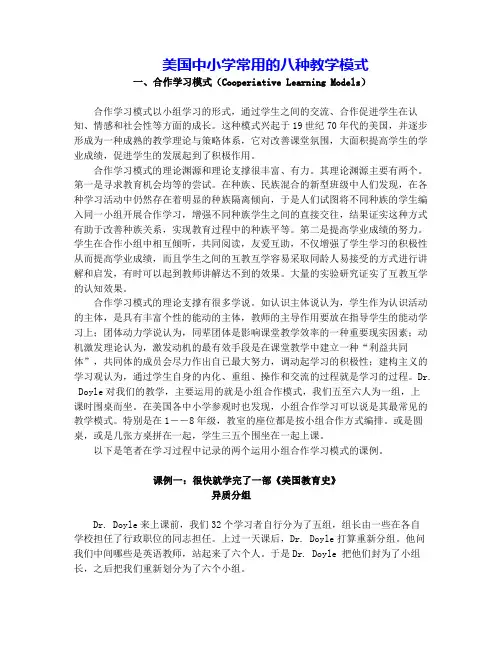
美国中小学常用的八种教学模式一、合作学习模式(Cooperiative Learning Models)合作学习模式以小组学习的形式,通过学生之间的交流、合作促进学生在认知、情感和社会性等方面的成长。
这种模式兴起于19世纪70年代的美国,并逐步形成为一种成熟的教学理论与策略体系,它对改善课堂氛围,大面积提高学生的学业成绩,促进学生的发展起到了积极作用。
合作学习模式的理论渊源和理论支撑很丰富、有力。
其理论渊源主要有两个。
第一是寻求教育机会均等的尝试。
在种族、民族混合的新型班级中人们发现,在各种学习活动中仍然存在着明显的种族隔离倾向,于是人们试图将不同种族的学生编入同一小组开展合作学习,增强不同种族学生之间的直接交往,结果证实这种方式有助于改善种族关系,实现教育过程中的种族平等。
第二是提高学业成绩的努力。
学生在合作小组中相互倾听,共同阅读,友爱互助,不仅增强了学生学习的积极性从而提高学业成绩,而且学生之间的互教互学容易采取同龄人易接受的方式进行讲解和启发,有时可以起到教师讲解达不到的效果。
大量的实验研究证实了互教互学的认知效果。
合作学习模式的理论支撑有很多学说。
如认识主体说认为,学生作为认识活动的主体,是具有丰富个性的能动的主体,教师的主导作用要放在指导学生的能动学习上;团体动力学说认为,同辈团体是影响课堂教学效率的一种重要现实因素;动机激发理论认为,激发动机的最有效手段是在课堂教学中建立一种“利益共同体”,共同体的成员会尽力作出自已最大努力,调动起学习的积极性;建构主义的学习观认为,通过学生自身的内化、重组、操作和交流的过程就是学习的过程。
Dr. Doyle对我们的教学,主要运用的就是小组合作模式,我们五至六人为一组,上课时围桌而坐。
在美国各中小学参观时也发现,小组合作学习可以说是其最常见的教学模式。
特别是在1――8年级,教室的座位都是按小组合作方式编排。
或是圆桌,或是几张方桌拼在一起,学生三五个围坐在一起上课。




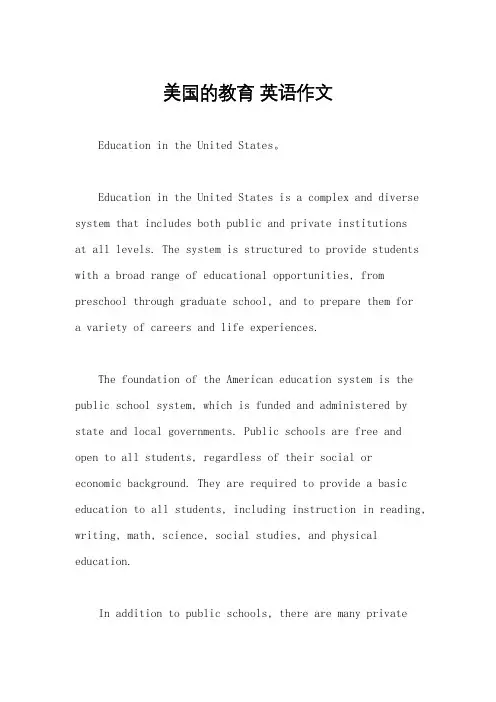
美国的教育英语作文Education in the United States。
Education in the United States is a complex and diverse system that includes both public and private institutionsat all levels. The system is structured to provide students with a broad range of educational opportunities, from preschool through graduate school, and to prepare them fora variety of careers and life experiences.The foundation of the American education system is the public school system, which is funded and administered by state and local governments. Public schools are free and open to all students, regardless of their social or economic background. They are required to provide a basic education to all students, including instruction in reading, writing, math, science, social studies, and physical education.In addition to public schools, there are many privateschools in the United States, which are funded by tuition and donations. Private schools vary widely in their size, curriculum, and philosophy, and can be religious or secular in nature. Some private schools offer specialized programsin areas such as the arts, technology, or international studies.Higher education in the United States is also diverse and includes a wide range of institutions, from community colleges to research universities. Community colleges offer two-year associate degrees and are often a more affordable option for students who want to complete their general education requirements before transferring to a four-year university. Four-year universities offer bachelor's degrees, and many also offer graduate programs that lead to master's or doctoral degrees.One of the unique features of the American education system is its emphasis on extracurricular activities. Students are encouraged to participate in sports, clubs,and other activities outside of the classroom, which can help them develop leadership skills, social connections,and a sense of community.Despite the strengths of the American education system, it also faces many challenges. One of the most significantis the achievement gap, which refers to the disparity in academic performance between different groups of students, particularly those from low-income and minority backgrounds. Other challenges include funding disparities between schools, teacher shortages, and the need to adapt torapidly changing technology and workforce demands.In conclusion, education in the United States is a complex and diverse system that provides students with a broad range of opportunities and prepares them for avariety of careers and life experiences. While there are many strengths to the system, there are also significant challenges that must be addressed in order to ensure thatall students have access to a high-quality education.。
美国教育的英语作文Education in the United States。
Education in the United States is highly valued and considered a key factor in achieving success. The education system in the U.S. is divided into three levels: elementary, secondary, and higher education.Elementary education, also known as primary education,is typically for children between the ages of 5 and 11. Children attend elementary school for six years and learn basic skills such as reading, writing, and arithmetic. Elementary schools often have a strong emphasis on socialization and character development.Secondary education, also known as high school, is for students between the ages of 12 and 18. High school is typically four years long and students are required to take a variety of courses including English, math, science,social studies, and physical education. High schools alsooffer elective courses in areas such as art, music, and foreign languages.In the U.S., higher education is not mandatory, but itis highly encouraged. Higher education includes collegesand universities, which offer a variety of degree programs such as associate's, bachelor's, master's, and doctoral degrees. Higher education is often seen as a means to achieve higher paying jobs and greater career opportunities.The U.S. education system places a strong emphasis on standardized testing, which is used to evaluate student performance and determine school funding. The most well-known standardized tests are the SAT and ACT, which are college entrance exams.One of the biggest challenges facing the U.S. education system is the achievement gap, which refers to thedisparities in academic performance between different demographic groups such as race, ethnicity, and socioeconomic status. Many efforts have been made toaddress the achievement gap, including increased fundingfor schools in disadvantaged areas and the implementation of programs aimed at improving academic performance.Overall, education in the United States is highly valued and seen as a key factor in achieving success. While there are challenges facing the education system, efforts are being made to address them and improve the quality of education for all students.。
英文作文美国教育In the United States, education is highly valued and seen as a fundamental right for all citizens. It is considered essential for personal and professional development, and plays a crucial role in shapingindividuals' future opportunities.The American education system is diverse and offers a wide range of options for students, including public schools, private schools, and homeschooling. Each option has its own strengths and weaknesses, and parents can choose the best fit for their children based on their individual needs and preferences.One unique aspect of the American education system is its emphasis on extracurricular activities. Students are encouraged to participate in sports, arts, music, and other activities outside of the classroom, which helps to develop well-rounded individuals and build important life skills.Standardized testing is a hotly debated topic in the United States, with some arguing that it is an effective way to measure student achievement, while others believe it puts too much pressure on students and teachers, and does not accurately reflect a student's abilities.College education is a significant part of the American education system, and it is often seen as a gateway to better career opportunities. However, the rising cost of college tuition has become a major concern for many families, leading to discussions about the accessibility of higher education for all.In recent years, there has been a growing focus on incorporating technology into the classroom, with many schools adopting digital learning tools and online resources to enhance the learning experience. This shift towards technology has sparked discussions about the potential benefits and drawbacks of relying on digital platforms for education.Overall, the American education system is constantlyevolving and adapting to meet the needs of a diverse and rapidly changing society. While it has its challenges, it continues to play a crucial role in shaping the future of the nation.。